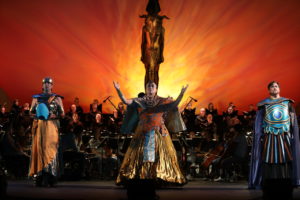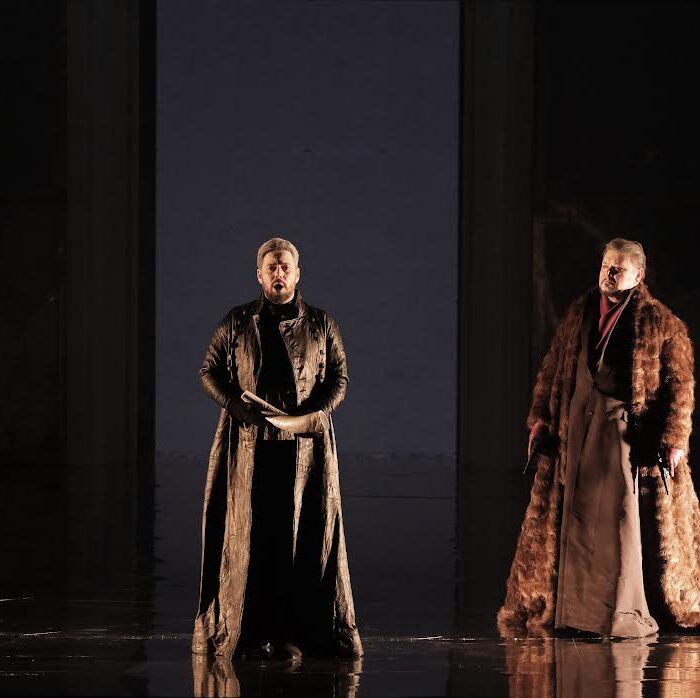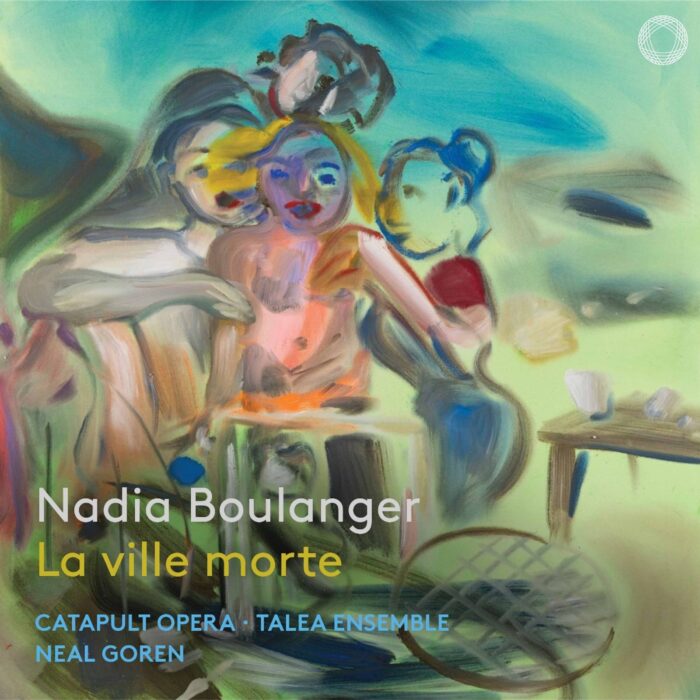
San Diego Opera 2019-20 Review: Aida
Michelle Bradley Shines In Unique Staging Of Verdi’s Classic
By Maria Nockin(Credit: Edward Wilensky)
On October 19, 2019, San Diego Opera presented Verdi’s “Aida” in a unique showcase that featured the orchestra and chorus on stage with the soloists, who were dressed up in traditional garb to reflect Ancient Egypt.
This was a different way of presenting opera and at the “Talk Back” immediately following the show it became obvious that opinions on its validity varied widely.
Strange Setting
The biggest challenge of this choice was how it could often come off as distracting.
Lighting Designer Chris Rynne had his work cut out for him with all the instrumental musicians needing light at their stands and the chorus members constantly reflecting light back into the audience during page turns.
Michael Yeargan’s set consisted of a wonderful curtain of hieroglyphics, two pyramids at the back of the stage, an idol that descend from above, and two staff-bearing figures on each side of the stage. With the whole orchestra on stage, there was no room for more.
With the help of Stage Director Alan E. Hicks, each of the principals created a memorable character that grew with the increasingly intense emotions of the libretto. Zandra Rhodes’ fabulous orange, blue and gold costumes helped the formation of these characterizations immeasurably by placing each soloist firmly in ancient Egypt. Although the costumes were rich and distinctive, each outfit allowed the artist wearing it to move gracefully in a manner befitting his or her character.
A Tremendous Verdian
But this production’s real power came from the soloists that brought Verdi’s famed score to life. At the core of it all was sensational American soprano Michelle Bradley, a winner of the George London-Leonie Rysanek award, who has been singing leading roles in Europe for the last few years. She has made her name especially as a renowned Verdi interpreter and the title role of Aida is definitely a wondrous achievement.
Every note she sang had a beginning, a middle, and an end that showed control over her large voice. All her utterances indicated she had given thorough consideration to various ways of expressing intense feelings on stage.
When she sang her aria “Ritorna vincitor,” she wanted to wish her lover good luck but a second later she realized she was asking for the defeat of her own people. That was the dilemma that Bradley pointed out in her Act one aria. She began full voice, but at its end she was able to spin the final “Numi pieta” into a gorgeous pianissimo.
Although Aida was submissive as Amneris’s slave, the audience could see her spirit was strong and that she was longing for rescue by her fathers’s army. Bradley’s voice had a huge dynamic range and a significant array of vocal colors with which to paint the emotions Aida felt. For her, the Nile Scene held no terrors because she had both a fortissimo and a pianissimo when she needed them.
She may have given a bit too much in the first three acts, however, and I felt she was tired in Act four. But after the exquisite performance she gave, she was entitled to be tired.
Fantastic Counterparts
Veteran tenor Carl Tanner has sung Radamès close to 150 times and, perhaps inspired by this excellent cast, he gave San Diego a most sonorous rendition. He sang a beautiful, distinctively phrased “Celeste Aida” that ended with a rousing high note instead of a pianissimo. He phrased his part gracefully with imagination and sensitivity from his first aria to his final “O terra addio.”
His acting was active if not energetic and he gave his audience a realistic characterization of the heroic leader who had fallen in love with an enemy alien. Most importantly, his resonant, bronze-tinged voice was a perfect counterpart for Bradley’s glorious Aida.
Olesya Petrova was a stern Amneris who, although she was a haughty princess, loved unwisely. She came into her own in the Judgment Scene and her “Anathema” was spine tingling.
When dealing with Aida and the priests, Petrova sang with enough venom in her voice to make the listener think of ear poison.
Nelson Martinez was a fierce, warlike Amonasro who created the characterization of an army general from an untamed land. His sound had a dark resonance to it but he sang with a slightly smaller tone than the rest of the soloists. Thus, the orchestra occasionally covered his baritone voice.
No Small Players
Two incredibly mellifluent basses with strong low notes, Simon Lim as Ramfis, the High Priest, and Mikhail Svetlov as the King of Egypt, rounded out the sound picture in the ensembles as they created singular characters.
Tenor Bernardo Bermudez was a lyrical and believable messenger, while Tasha Koontz sang the High Priestess with virginal tones.
The work of all these artists came together under the leadership of Maestro Joseph Colaneri. His propulsive but subtle account of the score brought out the truth that Verdi ably described every emotion known to humanity with perfect accuracy. Colaneri provided space for the singers to breathe, a sense of majesty for the Triumphal Scene, and urgent orchestral drama for the interpersonal conflicts. Playing with few rehearsals, the San Diego Symphony had only one or two slight lapses.
Chorus Master Bruce Stasyna’s stationary, score-reading, black-clad ensemble sang well as they shared the stage with the orchestra for Acts one and two.
But all in all, the singers themselves made this evening memorable to be sure.



